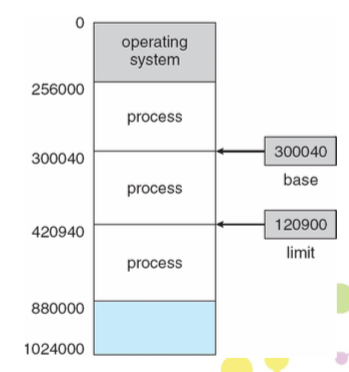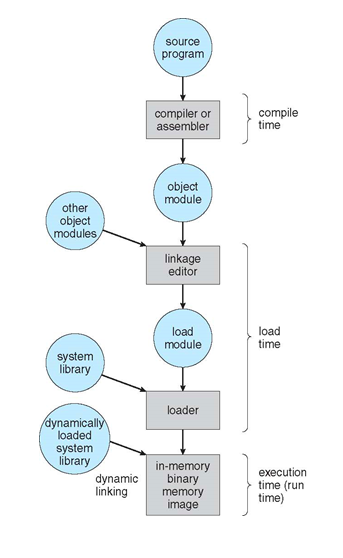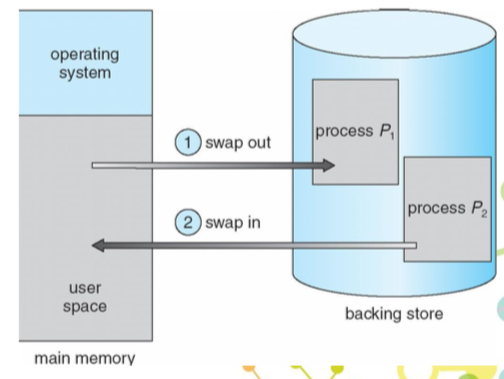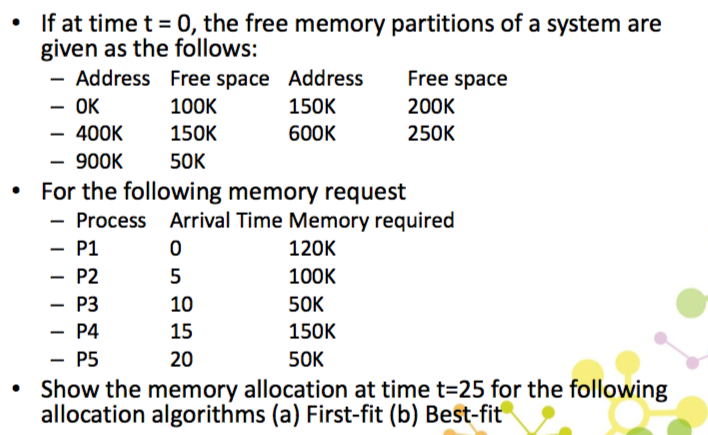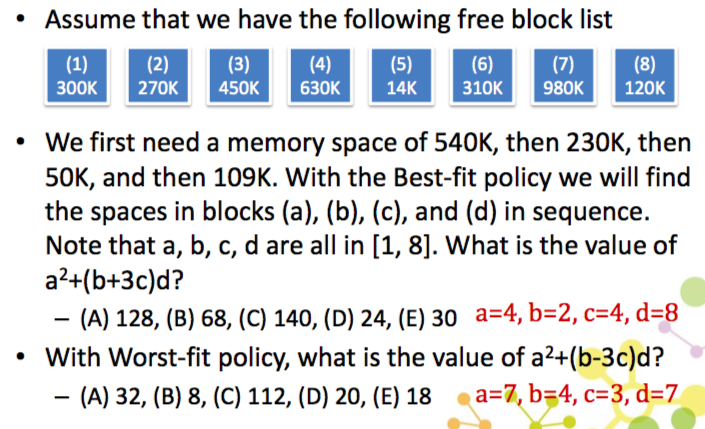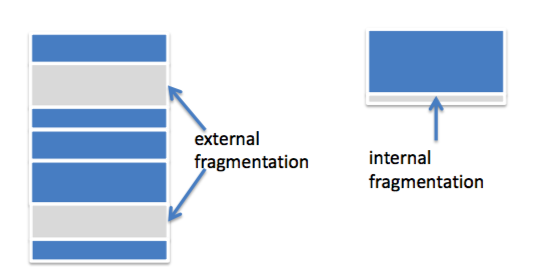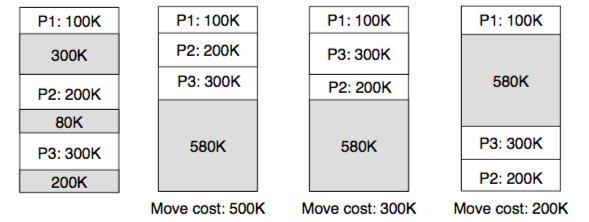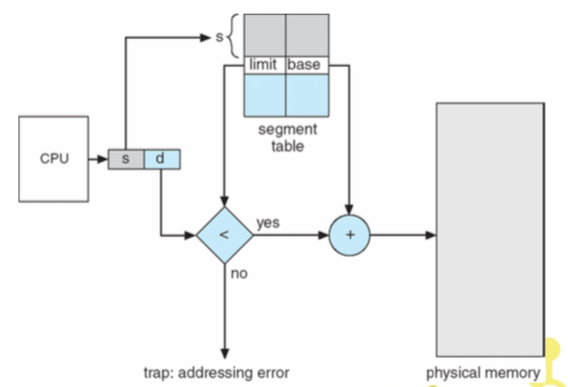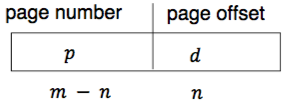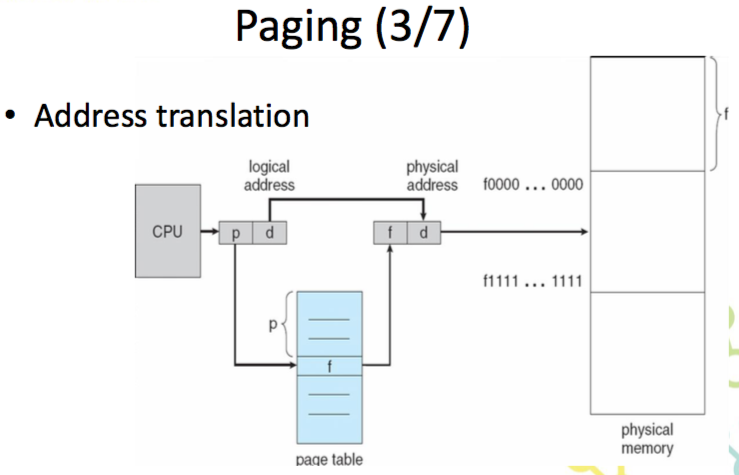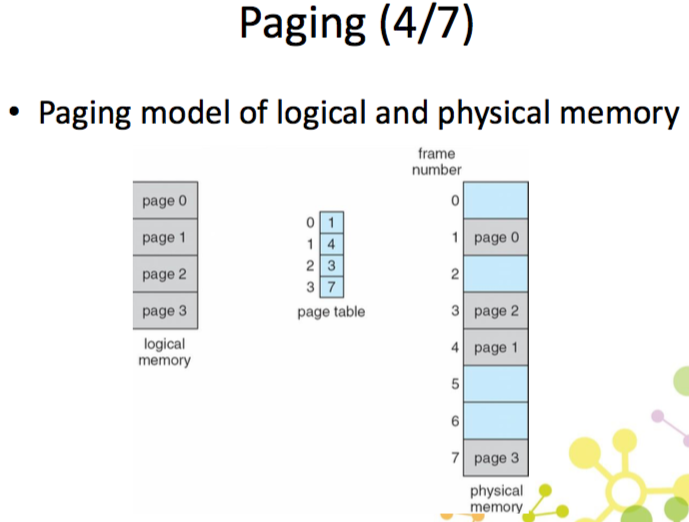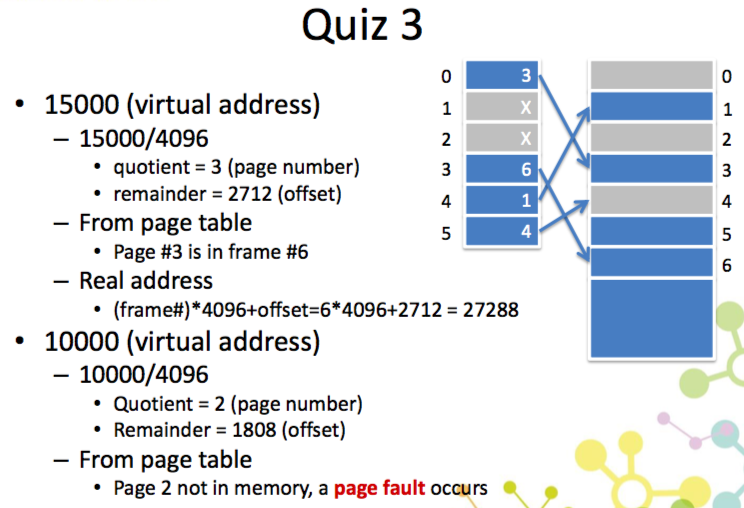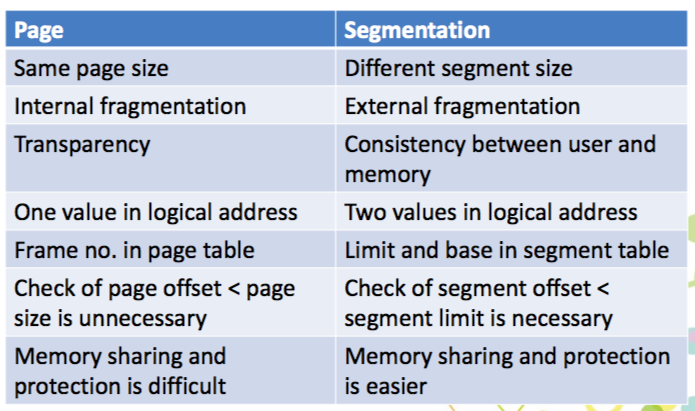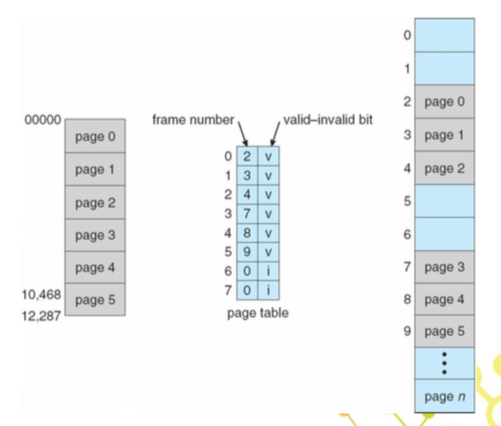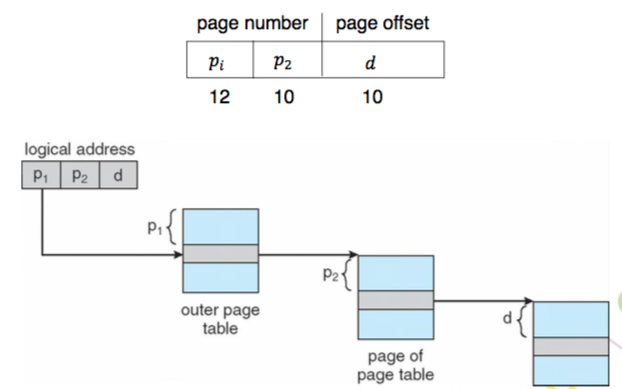CH8 記憶體管理 (Memory Management Strategies)
背景
目的
- 程式(program)必須從硬碟移動到記憶體中,並變成一個進程(process)才能執行
- CPU 只能直接存取,CPU 內暫存器(register)或記憶體(memory)的內容
- CPU 可以在一個時脈週期內,存取暫存器(register)多次
- 但是存取相同內容的話,存取記憶體(memory)可能要花數個 CPU 時脈週期(因為 memory 速率較 register 慢),照成 CPU 需要等待(stall)
- 補救方法就是,在快與慢之間加入存取速率中等的快取記憶體(cache)
基底暫存器與限制暫存器(Base and Limit Registers)
使用兩個暫存器記錄
- Base register:該 process 的起始記憶體地址,我們稱為基底暫存器
- Limist register:該 process 所佔記憶體地址大小,我們稱為限制暫存器
address binding
程式必須載入到記憶體後,變成 process 後才能執行。 在硬碟上等待被載入到記憶體執行得的所有行程,會形成一個輸入佇列(input queue)
編譯時間 (compile time):如果編譯時,程式所在的記憶體位置已知,那麼可產生絕對碼(absolute code)
- 缺點:但如果起始位置變化,要重新 compiler
載入時間 (load time):如果編譯時不能確定程式所在的記憶體位置,則必須生成 重定代(relocatable code)
- 缺點:但如果起始位置變化,要 reload
執行時間 (execution time):如果行程正要執行時,記憶體區段被移動到另一個區段,則連結時間才會延遲到這個時候(這需要硬體是否支援:MMU)
logical address 和 physical address
- logical address
- cpu 產生的
- virtul address
- physical address
- 真的送到 memory 的
- compile time 和 load time 的 address binding
- logical address = physical address
- execution time 的 address binding
- logical address != physical address
Memory-Management Unit (MMU)
硬體將 logical address 轉成 physical address
Dynamic Binding
- 在 execution time 才真正決定程式執行的起始位置,就是程式在執行時可以任意變動起始位置
- 但是需要額外的硬體支援 ex MMU
Dynamic Loading
- 在 execution time,當某個 module 被真正呼叫到的時候,才將他 load 到 memory 裡面(如果該 module 並不在 memory 裡面)
- 主要目的是想節省 memory 空間,發揮 memory 使用率(utilization)
Dynamic Linking
- 在 execution time,當某個 module 被真正呼叫到的時候,才將他 load 到 memory 裡面,並將他的 module 和 library 進行外部符號參考的解決(linking)
- 主要目的是想節省不必要的 linking time
- 也可以說是 shared libraries
swapping
- 也可以叫 backing store
- memory 不夠用了,優先權(priority)較低的會先被 swap out
Contiguous Allocation 連續
- fix-partition 大家都配置一樣的記憶體大小
- Variable-partition 配置的記憶體大小符合 process 大小
- 當 process 離開 memory 就會有洞(hole)產生,有幾種方法去填這個洞
- first-fit
- 從第一個洞開始找,找到可以塞進去的洞
- best-fit
- 檢查所有洞,找出最小的洞,且可以塞進去的洞
- worst-fit
- 檢查所有洞,找出最大的洞
- next-fit
- first-fit 的變形,因為每次找洞的時候,可能前面的洞已經很小的,但是還是要從前面開始找,就會浪費搜尋時間
- next-fit 從上次配置的 block 以下的洞開始找
- first-fit
例題 1
sol:
| 開始位置 | 結束位置 | 大小 |
|---|---|---|
| 0 | 100 | 100 |
| 150 | 350 | 200 |
| 400 | 550 | 150 |
| 600 | 850 | 250 |
| 900 | 950 | 50 |
(a) First-fit P1 需要 120 這時候 150 這個位置可以使用,150+120=270 所以 P1 在 150~270 剩下
| 開始位置 | 結束位置 | 大小 |
|---|---|---|
| 0 | 100 | 100 |
| 350 | ||
| 400 | 550 | 150 |
| 600 | 850 | 250 |
| 900 | 950 | 50 |
P2 需要 100 剛好 0 的位置可以用 所以 P2 在 0~100 剩下
| 開始位置 | 結束位置 | 大小 |
|---|---|---|
| 350 | ||
| 400 | 550 | 150 |
| 600 | 850 | 250 |
| 900 | 950 | 50 |
P3 需要 50 270 的位置可以使用,270+50=320 所以 P3 在 270~320 剩下
| 開始位置 | 結束位置 | 大小 |
|---|---|---|
| 350 | ||
| 400 | 550 | 150 |
| 600 | 850 | 250 |
| 900 | 950 | 50 |
P4 需要 150 400 的位置可以 P4 的位置是 400~550 剩下
| 開始位置 | 結束位置 | 大小 |
|---|---|---|
| 350 | ||
| 600 | 850 | 250 |
| 900 | 950 | 50 |
P5 需要 50 600 的位置可以,600+50=650 所以 P5 的位置是 600~650 答案
| 開始位置 | 結束位置 | 大小 | |
|---|---|---|---|
| P1 | 150 | 270 | 120 |
| P2 | 0 | 100 | 100 |
| P3 | 270 | 320 | 50 |
| P4 | 400 | 550 | 150 |
| P5 | 600 | 650 | 50 |
(b)best-fit P1 需要 120 看大小,150 大小最適合,400+120=520 所以 P1 在 400~520 剩下
| 開始位置 | 結束位置 | 大小 |
|---|---|---|
| 0 | 100 | 100 |
| 150 | 350 | 200 |
| 550 | ||
| 600 | 850 | 250 |
| 900 | 950 | 50 |
P2 需要 100 大小 100 的最適合 所以 P2 在 0~100 剩下
| 開始位置 | 結束位置 | 大小 |
|---|---|---|
| 150 | 350 | 200 |
| 550 | ||
| 600 | 850 | 250 |
| 900 | 950 | 50 |
P3 需要 50 50 的大小最適合 所以 P3 在 900~950 剩下
| 開始位置 | 結束位置 | 大小 |
|---|---|---|
| 150 | 350 | 200 |
| 550 | ||
| 600 | 850 | 250 |
P4 需要 150 200 的位置最適合 P4 的位置是 150~300 剩下
| 開始位置 | 結束位置 | 大小 |
|---|---|---|
| 350 | ||
| 550 | ||
| 600 | 850 | 250 |
P5 需要 50 300 的位置可以,300+50=350 所以 P5 的位置是 300~350 答案
| 開始位置 | 結束位置 | 大小 | |
|---|---|---|---|
| P1 | 400 | 520 | 120 |
| P2 | 0 | 100 | 100 |
| P3 | 900 | 950 | 50 |
| P4 | 150 | 300 | 150 |
| P5 | 300 | 350 | 50 |
例題 2
sol: (A) best-fit
| block | 大小 | P1 | P2 | P3 | P4 |
|---|---|---|---|---|---|
| 佔了 | 540 | 230 | 50 | 109 | |
| 1 | 300 | — | — | — | — |
| 2 | 270 | — | 40 | — | — |
| 3 | 450 | — | — | — | — |
| 4 | 630 | 90 | — | 40 | — |
| 5 | 14 | — | — | — | — |
| 6 | 310 | — | — | — | — |
| 7 | 980 | — | — | — | — |
| 8 | 120 | — | — | — | 11 |
a=4 b=2 c=4 d=8
sol: 我算出來是 14 耶 但沒這選項 worst-fit
| block | 大小 | P1 | P2 | P3 | P4 |
|---|---|---|---|---|---|
| 佔了 | 540 | 230 | 50 | 109 | |
| 1 | 300 | — | — | — | — |
| 2 | 270 | — | — | — | — |
| 3 | 450 | — | — | 400 | — |
| 4 | 630 | — | 300 | — | — |
| 5 | 14 | — | — | — | — |
| 6 | 310 | — | — | — | — |
| 7 | 980 | 440 | — | — | 331 |
| 8 | 120 | — | — | — | — |
a=7 b=4 c=3 d=7
連續配置結論
比較
| 時間效益 | 空間利用度| | |
|---|---|---|
| first-fit | 優 | ≒ 優 |
| best-fit | 差 | 優 |
| worst-fit | 差 | 差 |
first-fit 比較好
- 不論是哪一種,都會有 external fragmentation 發生
- 在連續配置方法下,可能記憶體中所有 free block 的 size 總和>=process 需求大小,但是因為這些 free block 不連續,所以無法使用,造成 memory 的浪費
- 配置完所剩的極小的 free block 一樣會在 available list 裡面,會增加 searching time 和記錄成本
Fragmentation
空間的浪費
- External Fragmentation 外部斷裂
- Variable-partition 會發生
- 解決方法:
- compaction
- page memory management
- Internal Fragmentation 內部斷裂
- fix-partition 會發生
compaction
進行壓縮,定期清理 memory。 就是移動執行中的 process 使得非連續的 free block 可以聚集在一起,形成更大的 free block
缺點:
- 需要各 process 為 Dynamic Binding 的支援,否則無法移動 process
- 很難有 Optimal Compaction
非連續的配置 - Segmentation
- user view
- logical address 分為 segement number(s)、offset(d)
- 利用 segment table
- base
- segment 在 physical address 起始位置
- limit
- segment 的長度(大小)
- Segment-table base register (STBR)
- segment table 的 physical address
- Segment-table length register (STLR)
- process 用了幾個 segment
- segment number s < STLR 才是 legal 的
- base
- 優點:
- 可以配置不連續 physical memory
- 沒有 internal Fragmentation
- share memory 和 protection
- 缺點:
- external fragmentation
- 需要額外的硬體
- 較多 memory access time
address translation
- 如何轉換
- 取得 segement number 之後
- 利用 segement table 去找到他的 base,就才可以計算起始位置
- 把 base+offset 才是真的起始位置
- 加上 limit 就是他在 physical address 結束位置
非連續的配置 - page
- frames
- 把 physical memory 分割成 fixed-sized blocks => 叫做 frames
- pages
- 把 logical memory 按照一樣 size 切割 => 叫做 pages
- page size = frame size
- 利用 page table,儲存 page、frame 關係
- 一個 page 對應一個 frame
- 在 os 裡面
- 每一個 process 有自己的 page
- 優點:
- 可以配置不連續 physical memory,
- 沒有 external Fragmentation
- share memory 和 protection
- 缺點:
- internal fragmentation
- 切得越小,可以減少 internal Fragmentation
- internal fragmentation
address translation
cpu 產生的 virtual address(logical address)可以被分成
- page number(p)
- 在第幾個 page
- page offset(d)
- 這個 page 的某一個位置
- page number(p)
假設 logical address 是 2^m,page size 是 2^n,就可以得知下圖
- 如何轉換
- 得到 page number 和 page offset 之後
- 去 page table 查詢 page number 對應的 frame number
- physical address = frame number + page offset
例題 3
例題 4
問題: Given a computer system with a 52-bit virtual address, 4KB pages, and 4 bytes per page entry. Suppose that the maximum physical memory size is 512GB, and the system is byte-addressable. Let paging be implemented for the system. What is the number of bits for physical addresses, and what is the maximum number of pages for a process?
答案 a. 39 maximum physical memory size is 512GB 512GB = 2^9 * 2^30 = 2^39 => 39 個 bit
b. 2^40 virtual address 是 52-bit page-offset 的長度 => page-size 是 4KB = 2^12 bit page-number 的長度 => 52-12 = 40 page 最大數是 2^40
page 和 segmentation 比較
Page Table 實作
PTBR
- 存 page table 的 physical address
- 存在 PCB (process control block)裡面
- context-swich 會重新 load
當要讀 memory 的 data/instruction 其實是要 access 兩次
- 一次是讀 page table
- 一次是讀 data/instruction
解決兩次 access => fast-lookup hardware cache => associative memory 或是 translation look-aside buffers (TLBs)
Paging Hardware With TLB
Associative Lookup = 𝜀 time unit Hit ratio = 𝛼 EffectiveAccessTime(EAT)= (1+𝜀)𝛼 + (2+𝜀) (1−𝛼) = 2+𝜀−𝛼
例題 5
memory protection
- 在每一個 frame 都加上 protection bit
- valid
- invalid
- PTLR
- 存 page table 的長度
share pages
- One copy of read-only (reentrant) code
- library
- 例如 text editors, compilers, window systems
- 可以不同的 logical address 但都指到相同的 physical address
例題 6
23A01180 =>0010 0011 1010 0000 0001 0001 1000 0000
page-size 是 2^10,所以扣掉後面 10 個 bit,才是 page-number =>00 1000 1110 1000 0000 0100 =>08E804
08E804 對應到的是 03A0117F =>0000 0011 1010 0000 0001 0001 0111 1111
後面再加上 page-offset =>+01 1000 0000 =>00 0000 1110 1000 0000 0100 0101 1111 1101 1000 0000 => 0E8045FD80 就是 physical address
Structure of the Page Table
把單一 page table 的 size 變小,比較好塞
- Hierarchical Page Tables
- Two-Level Paging
Two-Level Paging
- 三次 memory access
- forward-mapped page table

